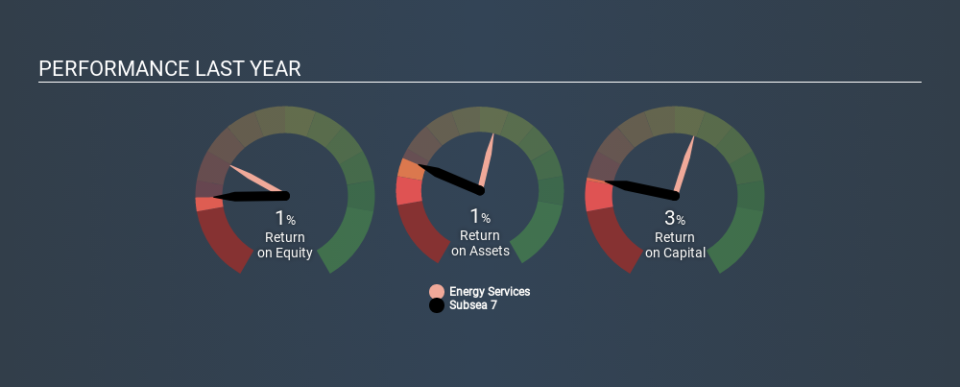Is Subsea 7 S.A. (OB:SUBC) Investing Your Capital Efficiently?

Today we'll look at Subsea 7 S.A. (OB:SUBC) and reflect on its potential as an investment. To be precise, we'll consider its Return On Capital Employed (ROCE), as that will inform our view of the quality of the business.
First, we'll go over how we calculate ROCE. Then we'll compare its ROCE to similar companies. Then we'll determine how its current liabilities are affecting its ROCE.
What is Return On Capital Employed (ROCE)?
ROCE measures the 'return' (pre-tax profit) a company generates from capital employed in its business. Generally speaking a higher ROCE is better. Overall, it is a valuable metric that has its flaws. Renowned investment researcher Michael Mauboussin has suggested that a high ROCE can indicate that 'one dollar invested in the company generates value of more than one dollar'.
How Do You Calculate Return On Capital Employed?
Analysts use this formula to calculate return on capital employed:
Return on Capital Employed = Earnings Before Interest and Tax (EBIT) ÷ (Total Assets - Current Liabilities)
Or for Subsea 7:
0.026 = US$160m ÷ (US$7.5b - US$1.4b) (Based on the trailing twelve months to September 2019.)
Therefore, Subsea 7 has an ROCE of 2.6%.
View our latest analysis for Subsea 7
Does Subsea 7 Have A Good ROCE?
One way to assess ROCE is to compare similar companies. In this analysis, Subsea 7's ROCE appears meaningfully below the 6.6% average reported by the Energy Services industry. This performance could be negative if sustained, as it suggests the business may underperform its industry. Regardless of how Subsea 7 stacks up against its industry, its ROCE in absolute terms is quite low (especially compared to a bank account). Readers may wish to look for more rewarding investments.
Subsea 7's current ROCE of 2.6% is lower than 3 years ago, when the company reported a 14% ROCE. Therefore we wonder if the company is facing new headwinds. You can click on the image below to see (in greater detail) how Subsea 7's past growth compares to other companies.
It is important to remember that ROCE shows past performance, and is not necessarily predictive. ROCE can be misleading for companies in cyclical industries, with returns looking impressive during the boom times, but very weak during the busts. ROCE is only a point-in-time measure. We note Subsea 7 could be considered a cyclical business. Since the future is so important for investors, you should check out our free report on analyst forecasts for Subsea 7.
How Subsea 7's Current Liabilities Impact Its ROCE
Current liabilities include invoices, such as supplier payments, short-term debt, or a tax bill, that need to be paid within 12 months. Due to the way ROCE is calculated, a high level of current liabilities makes a company look as though it has less capital employed, and thus can (sometimes unfairly) boost the ROCE. To check the impact of this, we calculate if a company has high current liabilities relative to its total assets.
Subsea 7 has current liabilities of US$1.4b and total assets of US$7.5b. As a result, its current liabilities are equal to approximately 19% of its total assets. This is not a high level of current liabilities, which would not boost the ROCE by much.
Our Take On Subsea 7's ROCE
That's not a bad thing, however Subsea 7 has a weak ROCE and may not be an attractive investment. Of course, you might also be able to find a better stock than Subsea 7. So you may wish to see this free collection of other companies that have grown earnings strongly.
If you like to buy stocks alongside management, then you might just love this free list of companies. (Hint: insiders have been buying them).
If you spot an error that warrants correction, please contact the editor at editorial-team@simplywallst.com. This article by Simply Wall St is general in nature. It does not constitute a recommendation to buy or sell any stock, and does not take account of your objectives, or your financial situation. Simply Wall St has no position in the stocks mentioned.
We aim to bring you long-term focused research analysis driven by fundamental data. Note that our analysis may not factor in the latest price-sensitive company announcements or qualitative material. Thank you for reading.



